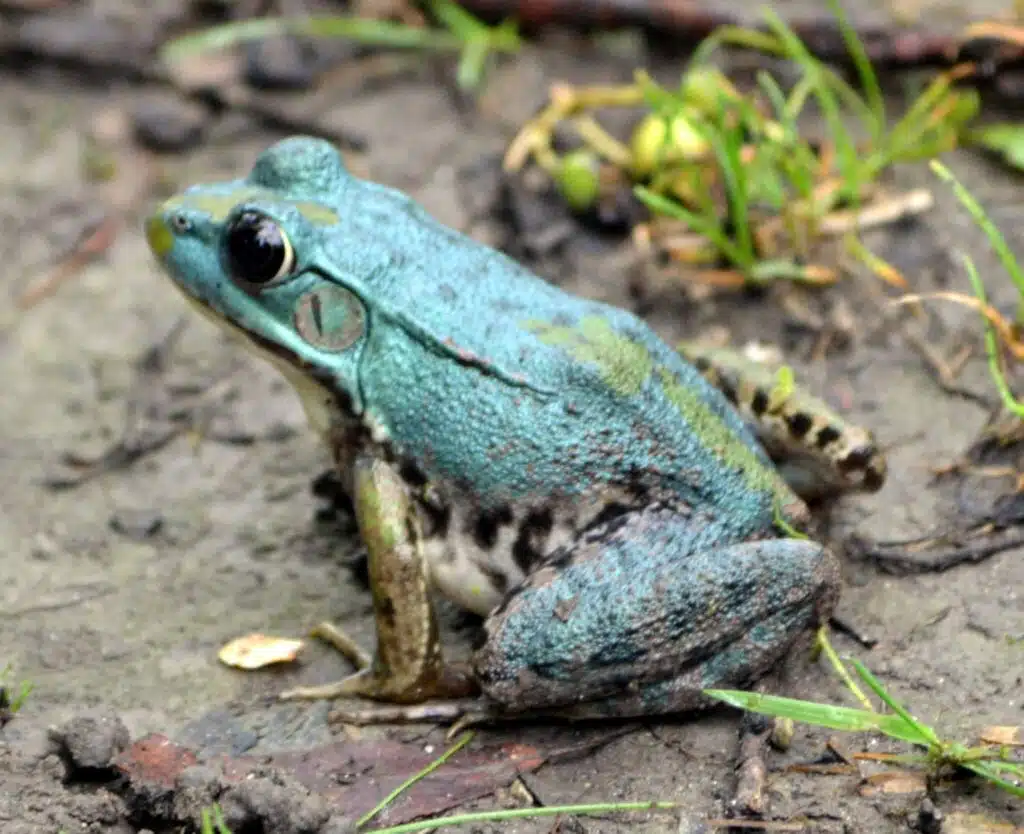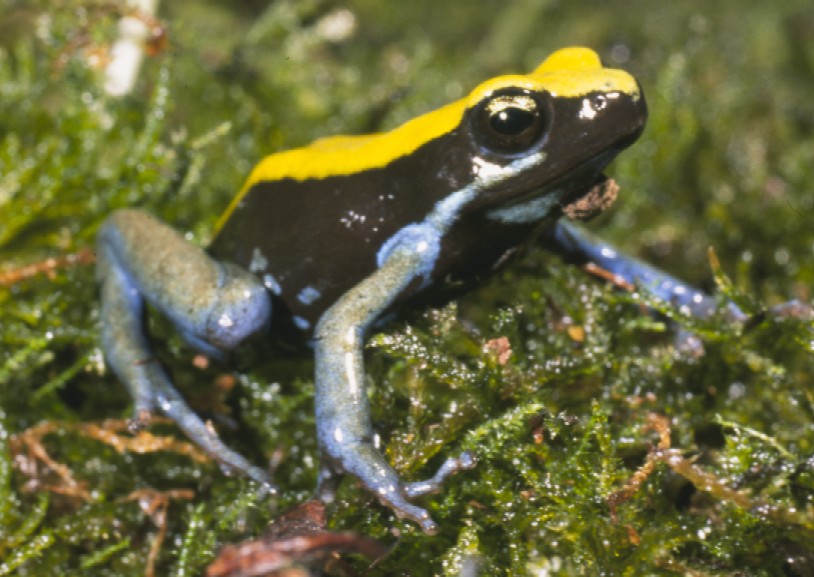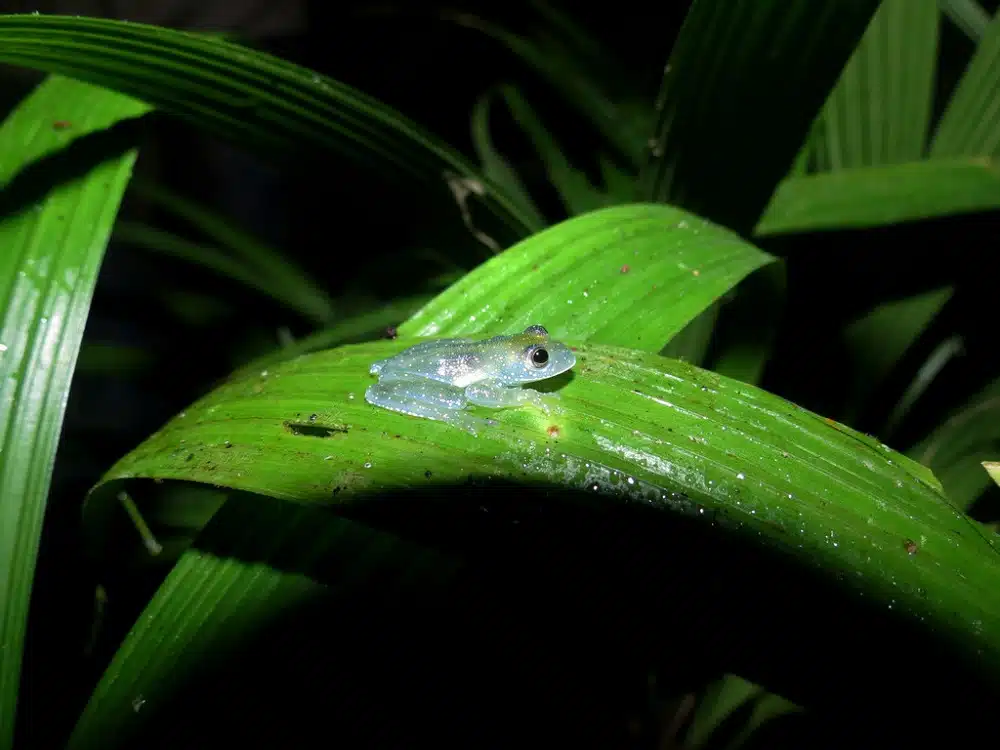One of the rarest types of frog colors is blue. Multiple species of the world come in this color but almost no frogs in The United States are dominated by blue nuances.
Blue frogs of the world may be occasionally blue. Some are blue in the breeding season while others have blue morphs.
Table of Contents
Are Blue Frogs Poisonous?
There are no poisonous blue frogs in The United States. This is the role of the more common Pickerel Frogs.
However, there are many types of poisonous blue frogs living in Central and South America.
The poison released through the skin may be so powerful that it can kill animals and even humans.
Some of the most dangerous blue frogs in the world are those in tropical forests.
Often relying on their poison as a last resort, these types of frogs have even been collected for their poison.
Often bred in captivity in places such as zoos, blue frogs are known to be highly poisonous. Denver Zoo names Blue Dart Frogs as one of the most poisonous frogs and even one of the most poisonous amphibians in the world.
Here are some of the most unique-looking blue frogs, both poisonous and non-poisonous.
Types of Blue Frogs
The following species come in different shades of blue.
1. White Tree Frog

White Tree Frogs (Ranoidea caerulea) grow to a size of up to 4 inches and are found around the world. A native of Australia, this type of frog has a green base nuance with blue or white nuances.
Its name varies around the world. Once introduced to Europe, this species has been influenced to change its color to blue, which led to its nickname of The Blue Tree Frog.
A common species in the frog pet industry, this is a non-poisonous frog with waxy skin. This coating helps it live in some of the warmest regions of Australia.
Nocturnal by nature, White Tree Frogs only come out at night and they prefer to hide during the day.
Where they live – Australia, New Guinea
2. Moor Frog

Like many other species, Moor Frogs (Rana arvalis) are widely impacted by their mating season when it comes to coloring.
For a very short period of the year, male Moor Frogs have a bright blue coloring. This period is the peak activity of their breeding season, a period when the male frogs are seen calling.
Choosing shallow water locations for calling, male Moor Frogs gather in choruses. All of them turn blue and dark blue when they want to attract females.
Even more, these frogs can become ultraviolet to stand out to females more. These fine color changes aren’t even visible to the human eye.
Female Moor Frogs aren’t blue at all. They are brown and remain brown even going into the peak breeding season period.
While this season starts in March and may last up to late June, the peak breeding season might take place in May-June.
Where they live – Europe, Asia
3. Blue Poison Dart Frog

Not all frogs of a species look the same. Some exceptions apply in the world of animals that look different from one individual to another, even in the case of the same species.
This is also the case with Blue Poison Dark Frogs (Dendrobates tinctorius “azureus”).
While these frogs are blue, they are further individualized by a pattern of black patterns.
Each frog has a combination of different sizes, shapes, and a number of black dots on the back.
This makes each blue frog of the species highly distinguishable and one of the ways these frogs identify each other.
Dominated by bright blue and dark blue nuances, these frogs are also highly poisonous, with the capacity to kill large predators upon contact.
Where they live – Suriname
4. Strawberry Poison Dart Frog

A species of The Americas with occasional US presence, Strawberry Poison Dart Frogs (Oophaga pumilio) come in different morphs.
A red and blue morph is common in regions of Panama and Costa Rica, but not in Southern US states.
A morph referred to as Blue Jeans, the red and blue morph comes with a mostly red color with blue legs.
Living in forests among ground leaves, Strawberry Poison Dart Frogs can also be all-red. A green and yellow morph with black spots is also more common than its red and blue morph.
As its name implies, this is also a poisonous species of frog best avoided by humans.
Where they live – Panama, Costa Rica
5. Northern Pacific Tree Frog

Temporary pools are among the preferred habitats of the highly variable Northern Pacific Tree Frog (Pseudacris regilla).
This is a species found along the Western US Coast, where it inhabits vast territories but where it may also come in different colors.
Its morphs are determined by genetics, location, and breeding season.
Some of the most atypical types of Northern Pacific Tree Frogs are actually blue. These types of frogs are spotted in Kittitas County.
Only males of the species are bright blue. Even males are only blue when they are most actively calling.
Their blue appearance is further highlighted by decorative blue dots.
Where they live – Washington state
6. Amazon Milk Frog

Some frogs are red, yellow, green, or brown. Amazon Milk Frogs (Trachycephalus resinifictrix) have very unusual green-blue colors which dominate their ventral side as well as their mouths.
The pale blue colors of these frogs are mostly seen on their underside as this is where they show uniform coloring.
They are also blue dorsally, but it’s here they show a black pattern as well. This pattern may be all-black or black with tiny blue dots.
Frogs of this group live in the Amazon Rainforest. They like very high humidity and can be found in different colors deep in the forest.
Apart from their specific coloring and habitat, these types of frogs are further known for releasing a substance similar to milk when under threat.
Where they live – Amazon Rainforest
7. Green Frog

Eastern and Southern US habitats are home to The Green Frog (Lithobates clamitans). A type of large green frog of North America, this is also a species that may occasionally be blue.
This is not something purposeful but the result of their incapacity to produce yellow pigments.
So what does the blue Green Frog morph to look like?
This is a morph with emerald-blue dorsum that features additional black dorsum spots. It’s also a morph with white bellies with additional white and black lateral colors.
Blue Green Frogs also have blue-green legs.
Where they live – Eastern US, The Gulf of Mexico
8. Fringe-Limbed Tree Frog

A small and often spotted species of Central America, Fringe-Limbed Tree Frogs (Cochranella euknemos) are among the species that can be green-blue.
Mostly green throughout the year, this is a frog species that becomes slightly green going into the breeding season.
Males change their green appearance to a slight blue appearance.
Tiny yellow spots are seen on these types of frogs. They act as small warning signals to potential predators in the forests these frogs live in.
Where they live – Costa Rica, Panama
9. Green-and-black Poison Dart Frog

At least 3 morphs are confirmed for the Green-and-black Poison Dar Frog (Dendrobates auratus).
This is a species that has base green coloring with black patterns. It may also come in blue coloring with black patterns.
Females of the species may also have an all-blue color with small black dorsal spots.
The species is not present in The United States but it has been accidentally introduced to Hawaii.
Where they live – Panama, Costa Rica, Colombia
10. Blue-legged Mantella

Blue-legged Manetllas (Mantella expectata) are among the endangered blue frogs of the world.
This is a species that only lives in a remote forest of Madagascar where it is locally known under different names.
The blue color of its legs inspires its official name. However, the frog is also yellow dorsally with considerable black lateral sections.
Blue legs are seen on males of the species during the breeding season. This is a period that lasts a few months from September to the end of the year.
Where they live – Madagascar forests
11. Blue-back Reed Frog

Also, a species of Madagascar, Blue-back Reed Frogs (Heterixalus madagascariensis) has bright blue dorsums.
This is a blue-gray nuance that is rather rare in the world of frogs, partly due to its genetics and partly due to its remote tropical Madagascar habitat.
Its bright blue dorsum is completed by either a bright yellow underbelly or a golden-yellow underbelly.
Thin black stripes with blue margins are further seen on the sides of the frog, expanding to its mouth.
Where they live – Madagascar
12. Ecuadorian Blue Glass Frog

This type of Andean frog (Cochranella mache) comes in both green and blue colors. Its dorsum has a bright green nuance with yellow marks and dots.
Blue areas are specific to its bellies and to its legs.
This is a species that grows to a size of just over 1 inch and which may also show additional blue nuances around the mouth, in the breeding season.
Where they live – Ecuador, Colombia